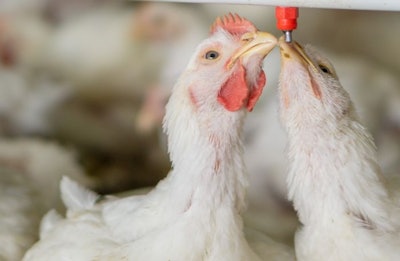
With deadlines for companies that have signed on to source chickens that align with the Better Chicken Commitment (BCC) approaching, the transition will not be a quick or easy one.
But Jeff Doyle, Compassion in World Farming (CIWF), U.S. head of food business, outlined areas in which those businesses should concentrate to make a smooth transition -- most businesses vowing to comply with the BCC have pledged to do so by 2024. Doyle offered that advice while speaking during the webinar, Better Chicken Commitment Breed Update, held on January 12. He was one of several people affiliated with CIWF and the Global Animal Partnership (GAP) to speak during the webinar.
Compassion in World Farming, an animal advocacy organization, states on its website that it "advocates on behalf of all areas that are detrimentally impacted by factory farming, including animals, the environment, public health, the environment, public health, and community and workers' justice."
GAP is a third-party animal welfare standards organization with strong ties to Whole Foods Market that has been pushing the poultry industry to switch to slower-growing breeds that would have what it refers to as "higher welfare outcomes."
During the webinar, speakers affiliated with CIWF and GAP often referenced a study conducted at the University of Guelph, which was largely funded through GAP.
Developers of the Better Chicken Commitment based its list of approved broiler breeds from the Guelph study. According to one version of the BCC, in order to be certified by the GAP, chicken suppliers will be required to adopt at least one of these breeds.
An article that offers more detail on GAP and BCC-approved breeds will appear in the February issue of WATTPoultryUSA.
That university study, however, has had its critics, partly because of its links to GAP, which has members of animal rights organizations on its board. Doubts about the validity of the research have also been expressed because of the relatively low number of chickens studied. Also, the National Chicken Council (NCC) earlier expressed concerns about how the conditions in which the trial chickens were raised did not necessarily mirror industry standards.
The study, according to the NCC, was also not peer-reviewed.
Despite skepticism and limited knowledge of the BCC, roughly 200 companies have publicly pledged to source chicken that complies with the BCC by 2024.
Doyle said those companies that have made those pledges can and should make the transition now.
“It is time to start internal and external conversations about breed transitions. We know breed transition at scale won’t happen overnight, but you can start working on it to set your company up for success in the future,” said Doyle.
Even if companies aren’t going to start sourcing broilers aligning with the Better Chicken Commitment immediately, there are some things to think about today, Doyle said. Among those are:
1. Engage with your suppliers
Doyle advises that companies can audit their current suppliers and consider if they are planning to provide poultry products that a business wants to serve to its customers. If these suppliers are not willing to provide such products, businesses would be wise to consider other suppliers that could help the company achieve its goals toward success.
2. Start sensory and cook testing
Doyle recommends that as producers start putting BCC-approved birds on the ground, that businesses that want to source those birds start doing sensory and cook testing. This will probably need to be done on a small scale in the early days.
3. Evaluate current products and consider future products
Companies who signed on with the BCC should be evaluating current products, as well as considering future products. It is time to think about product development, said Doyle. He believes there is an economic opportunity for dark meats not being fully realized. Doyle suggests that companies think about both what their products are like now, as well as what they might be like five years from now. Remember, too, he said, that just because products are new, it doesn’t mean they won’t be as appetizing or economically valuable for the company.
4. Consider sustainability
Critics of GAP and the BCC have questioned the sustainability of raising such breeds, citing more feed being used for longer growout times and that yields less meat.
During the webinar, Nicole Jenkins, CIWF U.S. food business manager, spent time talking about the BCC-approved breeds and their feed conversion ratios (FCR). She acknowledged that the breeds examined in the Guelph study were fed the same feed rations, a facet of the study that has led the NCC to question the study's validity.
But Jenkins and Doyle both said better FCRs could possibly be achieved as other feeds and considered.
For those businesses that are particularly concerned about sustainability, Doyle suggested that they work with suppliers or an non-governmental organization (NGO) to partner on exploring alternative feeds. Doyle said this is an opportunity that hasn’t been invested in sufficiently, but if realized, it can improve sustainability and higher welfare – not only for BCC breeds, but all broilers.
5. Develop procurement and financial plans
Procurement and financial plans definitely need to be looked at to assure success, said Doyle. Such considerations can be applied to meeting the desired timelines. It is important to involve different teams within the company, to make sure support across the business exists. By involving different teams within the company, it can help mitigate costs and help ease the transition for everybody.


















